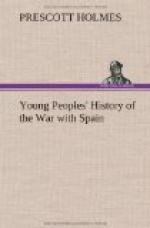[Illustration: President McKinley.]
Well, in spite of all that the United States had done to help Spain, matters grew worse, and finally the United States was obliged to tell Spain that, unless she took her soldiers away from the island and let the people govern themselves, she would help them to become a free and independent nation. When Spain received this message, she regarded it as a declaration of war, and both sides prepared for the conflict.
But before telling you about the war, shall I tell you something about the island and the group to which it belongs?
[Illustration: Map of the West Indies.]
The island is called Cuba. It belongs to a large group of islands known as the West Indies; a changed form of the old name, West Indias, given by Christopher Columbus, who thought that by sailing westward he had reached islands off the shore of India. If you look on a map of the Western Hemisphere, you will find the West Indies between the Caribbean Sea and the Atlantic Ocean.
Most of these islands are high and rocky, seeming like a chain of mountains in the ocean, with their tops above the waves. They are in the tropical regions, and the climate is very hot in the lowlands and on the coasts, but is delightful in the high parts all the year round. There are only two seasons—wet and dry. The rainy season begins in the spring or early summer, and lasts about six months.
What grows in these islands? Delicious fruits: mangoes, oranges, cocoanuts, limes, pineapples, and bananas; many other valuable crops: coffee, tobacco, maize, rice, sugar-cane, and cotton; immense forests of mahogany and other valuable trees. This beautiful vegetation makes these lands fair to look upon. Then, too, there are many birds with gorgeous plumage. The islands have gold, silver, copper, and iron mines; there are quarries of marble; and some kinds of precious stones are found.
But this region is not a paradise. Snakes and other horrid things crawl among the beautiful trees and foliage, and poisonous insects swarm in every place. Earthquake shocks are often felt, and fearful hurricanes sweep over the islands nearly every year, doing much damage.
A gentle race of Indians dwelt in these islands at the time of their discovery, but the Spanish settlers treated the natives so cruelly that after a few years they had ceased to exist. Many of the Indians were sent to Spain and other countries and sold as slaves; the rest were made to work in the mines, and as the Indians had never been used to such work, they died from the hard labor. In later times some of the islands were bought from Spain, others were captured, others were gained by treaty, by the nations to whom they now belong.
At the beginning of the war between the United States and Spain, in 1898, Cuba, as I have already said, belonged to Spain. Spain owned another large island, Puerto Rico, which we call Porto Rico, a name meaning “rich port.” But I need not say anything more about Porto Rico at present.




